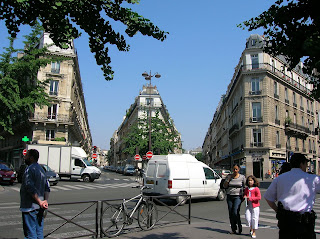I first moved to this neighborhood in 1972 -- right after I left the room-with-a-family that had been my home during what was supposed to have been my one year in Paris. I'd like to be able to tell you that I did a lot of research to find exactly the right place to live but, in fact, I chose it because it was just 8 métro stops away from my new job. Once again my lucky star took care of me as it's one of the greatest neighborhoods in Paris. Most people never leave the area even if they do change apartments within it. (I have lived in 3 different apartments on two streets in the time I've been here.)
At first, I just thought it was great because it was convenient to everything. But, gradually, I discovered that the Quartier d'Europe is much more. It was the handiwork of two financial speculators -- a Swedish banker and a French courtier -- who acquired the land in 1826 with the intention of creating a new residential area in a place that, at the time, was on the outskirts of Paris. They decided to name all the streets after European cities. The building, re-building and enlarging of the nearby Saint Lazare train station caused them to revise their plans somewhat but they persevered and finished their project about 1865 -- though the train station was finally finished 25 years after that. So-o-o glad I missed all the construction !
The area quickly became a center for muscians and artists and continues so to this day. The old Opera House (Palais Garnier) was opened in 1874 and is within walking distance. On my way to the grocery store, I sometimes hear a lovely soprano warming up and wonder if she sings at the Opéra. Nearly every time I take the métro, I dodge students carrying ungainly musical instruments on their way to the nearby Conservatory which opened in 1911. The street parallel to mine and even closer to the Conservatory is still THE place to have your violin, cello or guitar made or repaired. You can also buy other instruments and the music to play on them here.A number of impressionist painters were fascinated by this new residential area and by the Saint Lazare train station, symbol of modernity and progress at the time. For six years, Manet had his atelier in a former fencing studio.
Manet's studio
From his window, he could see my street and painted a well-known picture of it. He also painted a picture of a little girl looking at the trains, still a favorite occupation of little kids in the neighborhood. Monet painted the train station itself and Caillebotte preferred street scenes. I have fun sometimes taking photos and comparing them to the originals.
Like this:
My photo of my street.
My photo of a sunny day in Paris:
Caillebotte's painting of a rainy day in Paris:
Such a fun place to live!




